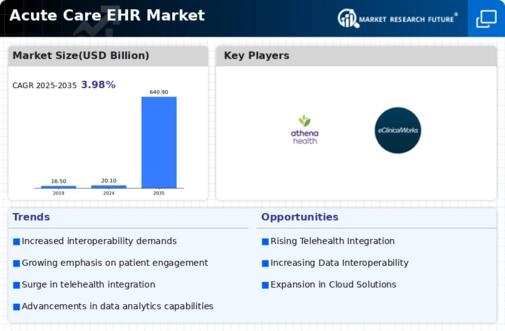Market Trends
Key Emerging Trends in the Acute Care EHR Market
The acute care EHR market is changing due to the digitization of healthcare information and the demand for simplified and integrated solutions. Major industrial shifts are driving these changes. Electronic health record systems are crucial for improving clinical processes, patient care, and healthcare professional communication. Cloud-based EHR solutions have transformed the acute care EHR market. Cloud computing delivers scalability, accessibility, and cost-effectiveness. Cloud-based EHR systems are being used by more acute care organizations. These solutions facilitate data storage, collaboration, and remote patient data access. Acute care EHRs aim for seamless interaction with other healthcare information systems. These systems are working toward interoperability, a priority. Interoperability improves patient care coordination and comprehensiveness. Making patient data available across departments and healthcare institutions does this. Mobile electronic health record (EHR) systems are growing more popular since they provide doctors greater flexibility and real-time patient data. Additionally, these solutions are gaining popularity. Clinicians may access their EHR data on cellphones and tablets via mobile apps. This improves acute care efficiency and helps physicians make decisions faster. Advanced clinical decision assistance is rapidly being added to acute care electronic health record systems. These technologies analyse patient data in real time and provide medical practitioners with evidence-based suggestions, warnings, and insights to improve clinical decision-making. Increasing clinical decision accuracy. Improved clinical decision assistance improves patient outcomes and safety. Patients are increasingly engaged in acute care EHR development, an important trend. Electronic health record systems use patient portals, encrypted communications, and health information interchange to empower people throughout their healthcare experience. Improved patient participation leads to better communication and shared decision-making with healthcare professionals. Collaboration affects both results. Telehealth is becoming more common, therefore acute care electronic health record systems now support it. This discovery allows EHRs to be smoothly integrated with telehealth consultations, virtual visits, and remote monitoring. This allows doctors to support these programs. Integrating telehealth supports the development of new healthcare delivery methods. Strong data analytics and reporting have been a major trend this year. Advanced analytics are being used in acute care EHRs to get insights from huge datasets. Improving patient care is the goal. These tools aid population health management, quality improvement, and regulatory reporting, making data-driven acute care choices simpler. As patient information becomes more digitized, acute care electronic health record systems emphasize cybersecurity. By taking strict security measures, providers ensure patient data confidentiality. These regulations include encryption, access limits, and audits. Cybersecurity vulnerabilities must be addressed to retain confidence in electronic health record systems. EHR systems with AI are becoming more prevalent in acute care. AI systems can analyze natural language, find medical data problems, and do predictive analytics. Electronic health record systems become more efficient with artificial intelligence, leading to more accurate diagnoses and customized treatment programs.









Leave a Comment